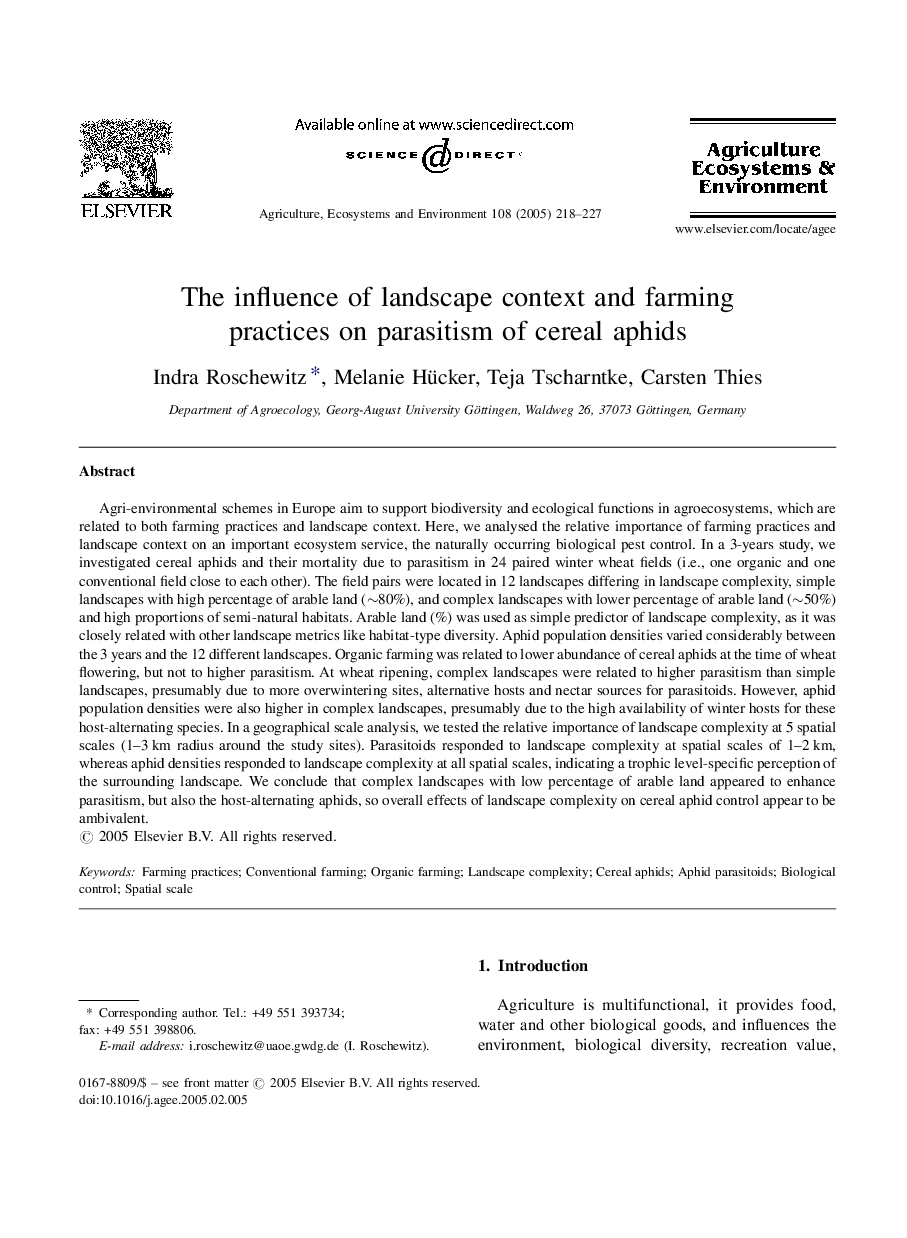| کد مقاله | کد نشریه | سال انتشار | مقاله انگلیسی | نسخه تمام متن |
|---|---|---|---|---|
| 8970844 | 1104003 | 2005 | 10 صفحه PDF | دانلود رایگان |
عنوان انگلیسی مقاله ISI
The influence of landscape context and farming practices on parasitism of cereal aphids
دانلود مقاله + سفارش ترجمه
دانلود مقاله ISI انگلیسی
رایگان برای ایرانیان
کلمات کلیدی
موضوعات مرتبط
علوم زیستی و بیوفناوری
علوم کشاورزی و بیولوژیک
علوم زراعت و اصلاح نباتات
پیش نمایش صفحه اول مقاله

چکیده انگلیسی
Agri-environmental schemes in Europe aim to support biodiversity and ecological functions in agroecosystems, which are related to both farming practices and landscape context. Here, we analysed the relative importance of farming practices and landscape context on an important ecosystem service, the naturally occurring biological pest control. In a 3-years study, we investigated cereal aphids and their mortality due to parasitism in 24 paired winter wheat fields (i.e., one organic and one conventional field close to each other). The field pairs were located in 12 landscapes differing in landscape complexity, simple landscapes with high percentage of arable land (â¼80%), and complex landscapes with lower percentage of arable land (â¼50%) and high proportions of semi-natural habitats. Arable land (%) was used as simple predictor of landscape complexity, as it was closely related with other landscape metrics like habitat-type diversity. Aphid population densities varied considerably between the 3 years and the 12 different landscapes. Organic farming was related to lower abundance of cereal aphids at the time of wheat flowering, but not to higher parasitism. At wheat ripening, complex landscapes were related to higher parasitism than simple landscapes, presumably due to more overwintering sites, alternative hosts and nectar sources for parasitoids. However, aphid population densities were also higher in complex landscapes, presumably due to the high availability of winter hosts for these host-alternating species. In a geographical scale analysis, we tested the relative importance of landscape complexity at 5 spatial scales (1-3Â km radius around the study sites). Parasitoids responded to landscape complexity at spatial scales of 1-2Â km, whereas aphid densities responded to landscape complexity at all spatial scales, indicating a trophic level-specific perception of the surrounding landscape. We conclude that complex landscapes with low percentage of arable land appeared to enhance parasitism, but also the host-alternating aphids, so overall effects of landscape complexity on cereal aphid control appear to be ambivalent.
ناشر
Database: Elsevier - ScienceDirect (ساینس دایرکت)
Journal: Agriculture, Ecosystems & Environment - Volume 108, Issue 3, 30 June 2005, Pages 218-227
Journal: Agriculture, Ecosystems & Environment - Volume 108, Issue 3, 30 June 2005, Pages 218-227
نویسندگان
Indra Roschewitz, Melanie Hücker, Teja Tscharntke, Carsten Thies,